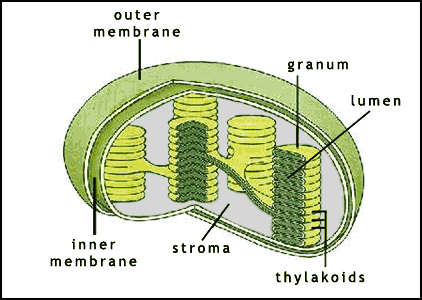Process of Photosynthesis: 6CO2 + 6H2O + light --> C6H12O6 + 6O2
The Light Reaction:
 The light reaction begins with taking photons from sunlight, sending these photons into the Photo Synthesis II and PS I. When in the PS II and I, the light bounces off pigments, eventually landing at the bottom, at the reaction center. Here, an electron gets "excited" from the energy collected from the photon, and the electron is shot from the PS II to the PS I. When this happens, energy is able to be used and push an H+ ion from the Stroma to the Lumen of the chloroplast (See upper diagram). Then, another electron in the PS I is "excited" and pushed to the stroma, where NADP+ picks it up and transfers to NADPH. The electron from PS II then replaces the electron from PS I. This brings up the problem: Where does the electron from PS II get replaced? To answer this, water is broken down into H+, e- and O2, where the e- replaces the other electron, and the H+ waits to be pushed into the Lumen.
The light reaction begins with taking photons from sunlight, sending these photons into the Photo Synthesis II and PS I. When in the PS II and I, the light bounces off pigments, eventually landing at the bottom, at the reaction center. Here, an electron gets "excited" from the energy collected from the photon, and the electron is shot from the PS II to the PS I. When this happens, energy is able to be used and push an H+ ion from the Stroma to the Lumen of the chloroplast (See upper diagram). Then, another electron in the PS I is "excited" and pushed to the stroma, where NADP+ picks it up and transfers to NADPH. The electron from PS II then replaces the electron from PS I. This brings up the problem: Where does the electron from PS II get replaced? To answer this, water is broken down into H+, e- and O2, where the e- replaces the other electron, and the H+ waits to be pushed into the Lumen.After this process, there are H+ in the Lumen, but because of diffusion, the H+ wants to go back down into the Stroma. They do this by going through the ATP synthase, where when they go down, ATP is reduced, producing ATP from the Light Reaction.
Inputs: Photons, water
Outputs: NADPH and O2
*NADPH to be used in the next step, the Calvin Cycle
The Calvin Cycle:
 In the Stroma of a chloroplast, the calvin cycle takes place, inputting CO2, ATP and using the NADPH produced in the light reaction. To start the cycle, 3 RuBP, a product already there in the cycle (a five carbon sugar) is joined with 3 C02 to produce 3 six carbon molecules. Because this six carbon molecule is so unstable, it is quickly broken down into 6 3-carbon molecules. Then, 6ATP and 6NADPH are oxidized and the energy from them is used to rearrange the 3 carbon molecules. After this, one 3 Carbon molecule (PGAL) is released, and the other 5 3 carbon molecules are rearranged into the starting RuBP, using the help of 3ATP. The PGALs taken out of this cycle are then used to form glucose, a sugar that can then be used in cellular respiration to make energy.
In the Stroma of a chloroplast, the calvin cycle takes place, inputting CO2, ATP and using the NADPH produced in the light reaction. To start the cycle, 3 RuBP, a product already there in the cycle (a five carbon sugar) is joined with 3 C02 to produce 3 six carbon molecules. Because this six carbon molecule is so unstable, it is quickly broken down into 6 3-carbon molecules. Then, 6ATP and 6NADPH are oxidized and the energy from them is used to rearrange the 3 carbon molecules. After this, one 3 Carbon molecule (PGAL) is released, and the other 5 3 carbon molecules are rearranged into the starting RuBP, using the help of 3ATP. The PGALs taken out of this cycle are then used to form glucose, a sugar that can then be used in cellular respiration to make energy.Inputs: CO2, NADPH and ATP
Outputs: Glucose
These two processes make up photosynthesis, producing sugars in plants for future use as energy.

Wow Megan this is sooo good! You did such a great job of describing photosynthesis in words! I don't think I could have done that which is why I used sketchfu. Nice work!
ReplyDeleteHey Megan
ReplyDeleteI really like your post! The video is really helpful, as are the visual aids. The context of the post is great and the information is well written out and easy to understand. Great post!
Great post, Megan! I really liked the multimedia that you used, it was very informative and helpful while I read the information. Your post was also very thorough and decisive. Nice job!
ReplyDeleteMegan! This is an amazing explanation of photosynthesis. You used a really good voice, which made the post really interesting to read. The use of the youtube video was also very helpful. I really like the picture of the Calvin Cycle, it's really clear and helpful!
ReplyDeleteMEGAN!
ReplyDeleteThis was QUITE the photosynthesis post. You made a very good, clear, detailed description of the goings on in this cellular process. You also made some nice use of multimedia with the video which added to the effect. Good job!
thorough explanation...be careful, though. ATP is also a product of the light reaction!
ReplyDelete